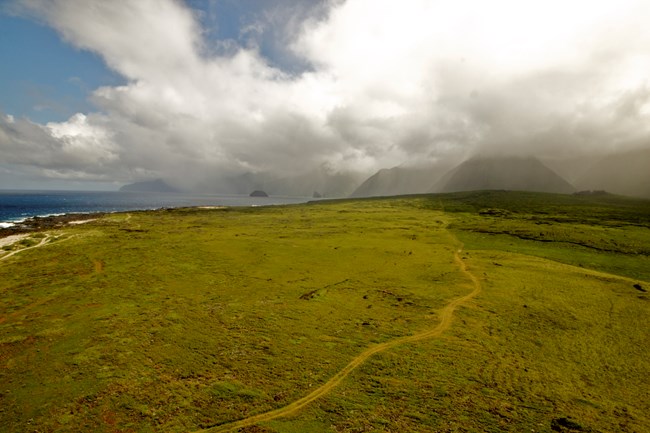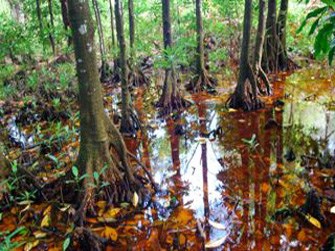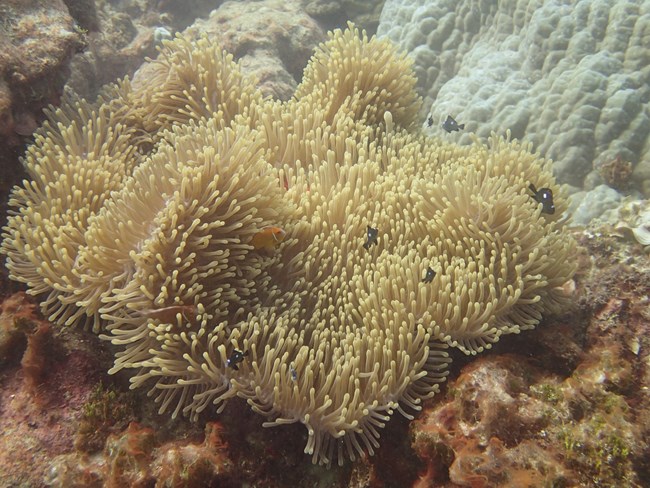Last updated: July 25, 2024
Article
Climate Change Clues from Monitoring
Change is a powerful force in nature, and islands are particularly susceptible to it. We have seen unprecedented climate change in the last few decades and climatologists expect the rate of change to increase. As climate changes, significant changes in weather conditions impact the natural environment by shifting patterns of precipitation, promoting extremes in storm behavior, and influencing bird migration, invasive species spread, coral reef decline, and much more. The Pacific Island Network (PACN) undertakes systematic long-term monitoring of a wide variety of natural resources to accurately determine if change is occurring and why.

Weather and Climate
Average temperatures on Pacific islands have risen by 0.5°F over the past century. Moreover, temperatures at higher elevations in Hawai‘i are now increasing by 0.48°F per decade. A warming climate increases the frequency and intensity of tropical storms and droughts. Hawai‘i has experienced a statewide decline in rainfall over the past two decades, which is predicted to continue. Projections of future climate depend on developing models that use existing weather data. Weather information is routinely recorded at stations in and near all PACN parks. The recent addition of several new park weather stations allows for near real-time tracking of weather conditions as well as providing climate modelers with more data to better predict the future climate
Terrestrial Vegetation and Landbirds
Higher elevation habitats in Pacific island national parks provide the primary refuge for native plants and animals. These elevations allow native birds in Hawai‘i to persist in areas where a threat like malaria-transmitting mosquitoes is low. Similarly, native vegetation throughout the Pacific tends to thrive where human disturbance is minimal, and conditions are not suitable for the plant and animal invaders that have transformed lower elevations. Warmer conditions allow avian disease-carrying mosquitoes to survive at higher elevations. This forces native birds to migrate even higher or face extinction. As the climate changes, these and other habitats are no longer certain refuges. Ninety-three percent of Hawaiian birds and 62% of all U.S. Pacific island birds are considered vulnerable to climate change. The National Park Service (NPS) is doing its part to learn about landbird population changes with the conclusion of the first landbird monitoring cycle at Haleakalā National Park, Hawai‘i Volcanoes National Park and the National Park of American Samoa. The cycle repeats at each park every five years.

Wet forests, mangroves, coastal strand habitats, and sub-alpine shrublands are vulnerable vegetation communities that are also monitored on a five year cycle. Projected rises in sea level and increases in large storm frequency may impact coastal strand and mangrove forests while inland vegetation may experience drier and warmer conditions.
Invasive plant species may become even more competitive, especially at higher elevations, as climatic conditions become more suitable. The NPS monitors both established and colonizing invasive species in the same habitats where vegetation communities are monitored.

Freshwater Animals, Water Quality, and Groundwater
Freshwater is the most valuable natural resource on Pacific islands for both people and the unique creatures that live in freshwater habitats. Water quality and quantity both below and above ground may be affected by climate change as rainfall declines and warmer temperatures promote evapotranspiration. At the same time, the rate of sea level rise is increasing (over one inch of rise per decade in Hawai‘i) and groundwater discharge to coastal environments can be reduced due to human withdrawal upslope. Treasured resources such as unique near-shore anchialine pools in Hawai‘i and wells on Guam may experience rising salinity as these hydrologic trends continue.

Perennial freshwater streams are rare on Pacific islands. Many still support unique native creatures especially in the upper stream reaches where invasive aquatic species are less established. The NPS annually monitors groundwater, water quality, and freshwater animals to provide managers the information they need to safeguard these waters and the native crustaceans, fish, and snails that inhabit them.
Coral Reef Communities
Oceans may absorb up to 90% of atmospheric CO2 over the next 1000 years, providing Earth with a huge buffering capacity against even more rapid climate change. However, this is already resulting in changes to the oceans, namely ocean acidification. Coral reef ecosystems and the great diversity of creatures that depend on them are especially threatened because their stony coral skeletons will not be able to form if the water is too acidic. Coral organisms are also very sensitive to heat stress and expel their colorful symbiotic algae (bleaching) when the water warms. Bleaching due to higher sea surface temperatures is increasing in the Pacific. Disease, reduced growth, and death often follow. In the next 50 years, temperature and CO2 levels are predicted to increase beyond levels that coral reefs have experienced for the past half million years.


Left image
Bleached coral observed in Guam during a mass bleaching event in 2013.
Right image
Coral reefs and the organisms they support are early indicators of climate change impacts.

Data from marine fish and coral reef monitoring detect not only changes in fish populations, but also changes in corals, invertebrates, and algae. The reefs of Kaloko-Honokōhau National Historical Park, Kalaupapa National Historical Park, National Park of American Samoa, and War in the Pacific National Historical Park are surveyed annually. These ecosystems are among the most immediate and effective indicators of climate change in the region.
For More Information
Pacific Island Inventory & Monitoring Network
Inventory & Monitoring at American Memorial Park
Inventory & Monitoring at Haleakalā National Park
Inventory & Monitoring at Hawai‘i Volcanoes National Park
Inventory & Monitoring at Kalaupapa National Park
Inventory & Monitoring at Kaloko-Honokōhau National Historical Park
Inventory & Monitoring at National Park of America Samoa
Inventory & Monitoring at War in the Pacific National Historical Park
Download PDF from the Data Store
Tags
- american memorial park
- haleakalā national park
- hawaiʻi volcanoes national park
- kalaupapa national historical park
- kaloko-honokōhau national historical park
- national park of american samoa
- war in the pacific national historical park
- pacn
- im
- pacific islands
- climate change effects
- weather
- coastal zone
- freshwater
- water quality
- groundwater
- benthic marine communities
- coral bleaching
- endemic species
- monitoring
- landbirds
- american memorial park
- haleakala national park
- hawaii volcanoes national park
- kalaupapa national historical park
- kaloko-honokohau national historical park
- national park of american samoa
- war in the pacific national historical park
- climate change
- oceans
- kalaupapa research
- pacific island network
